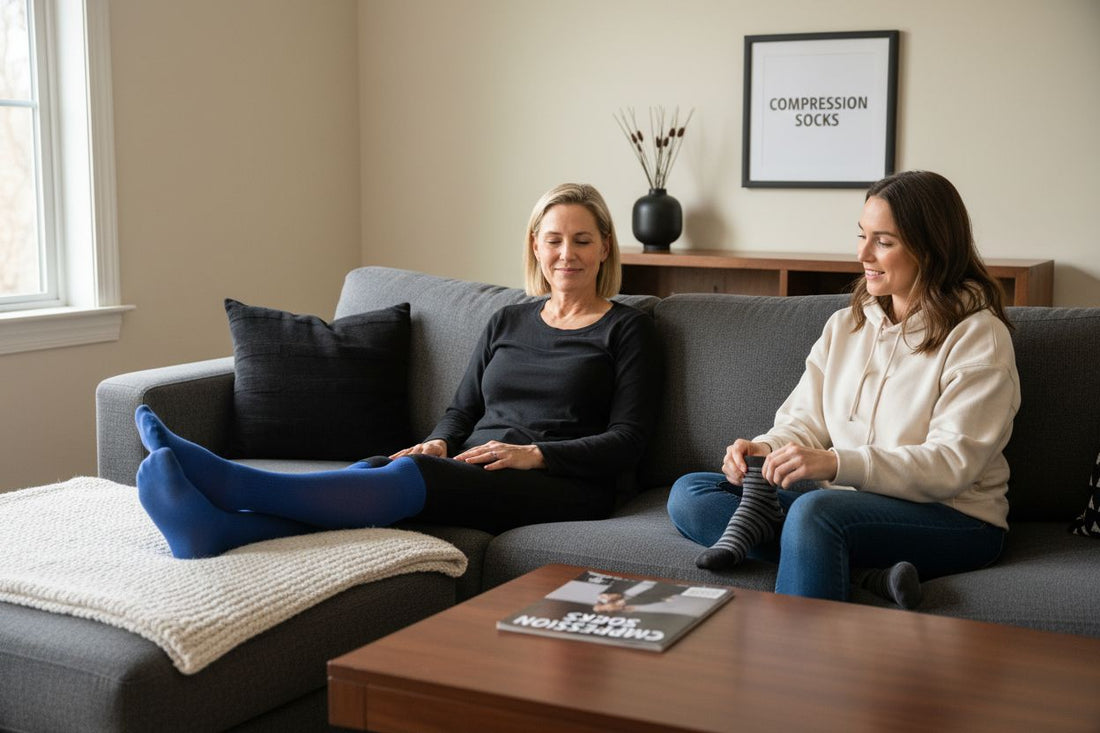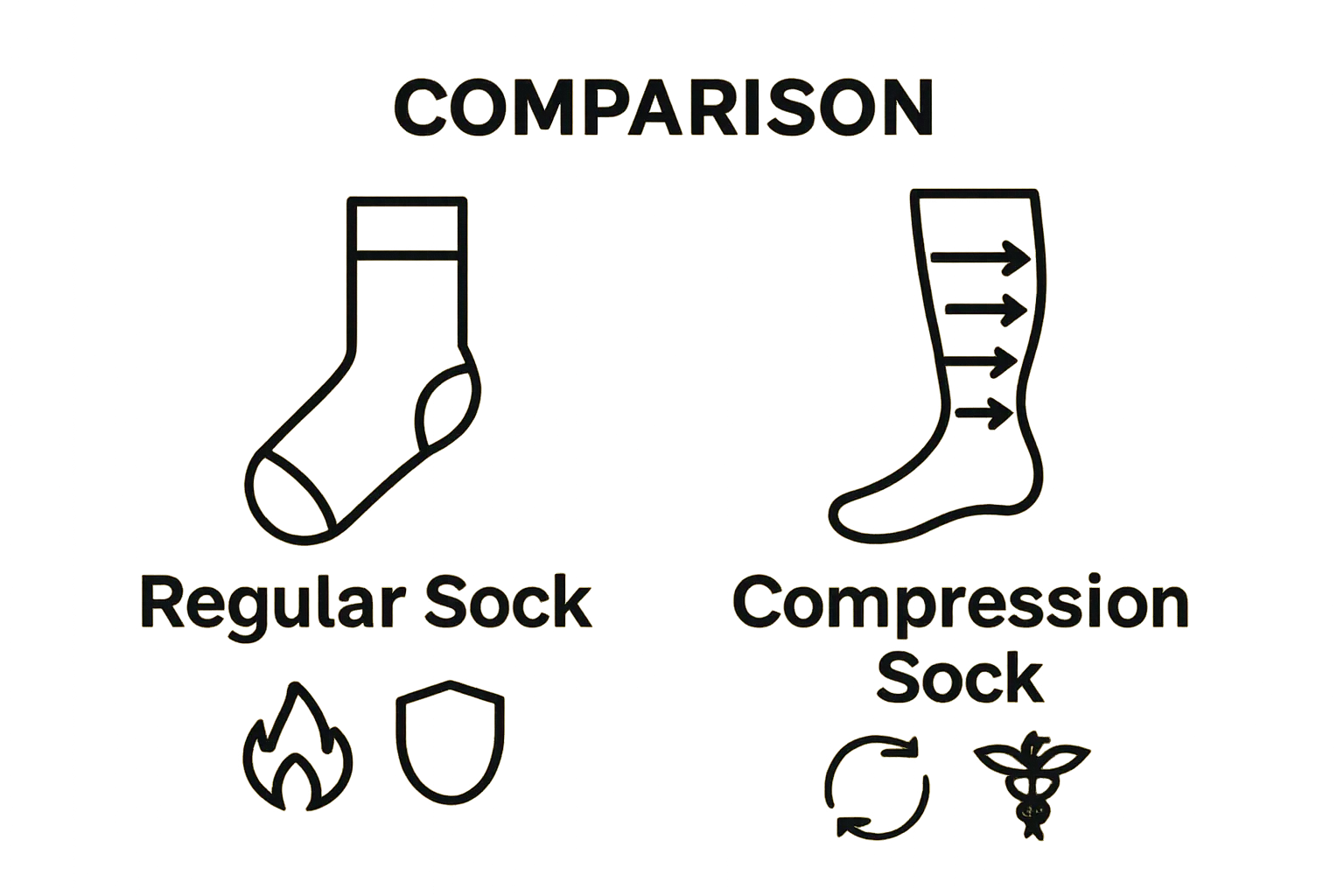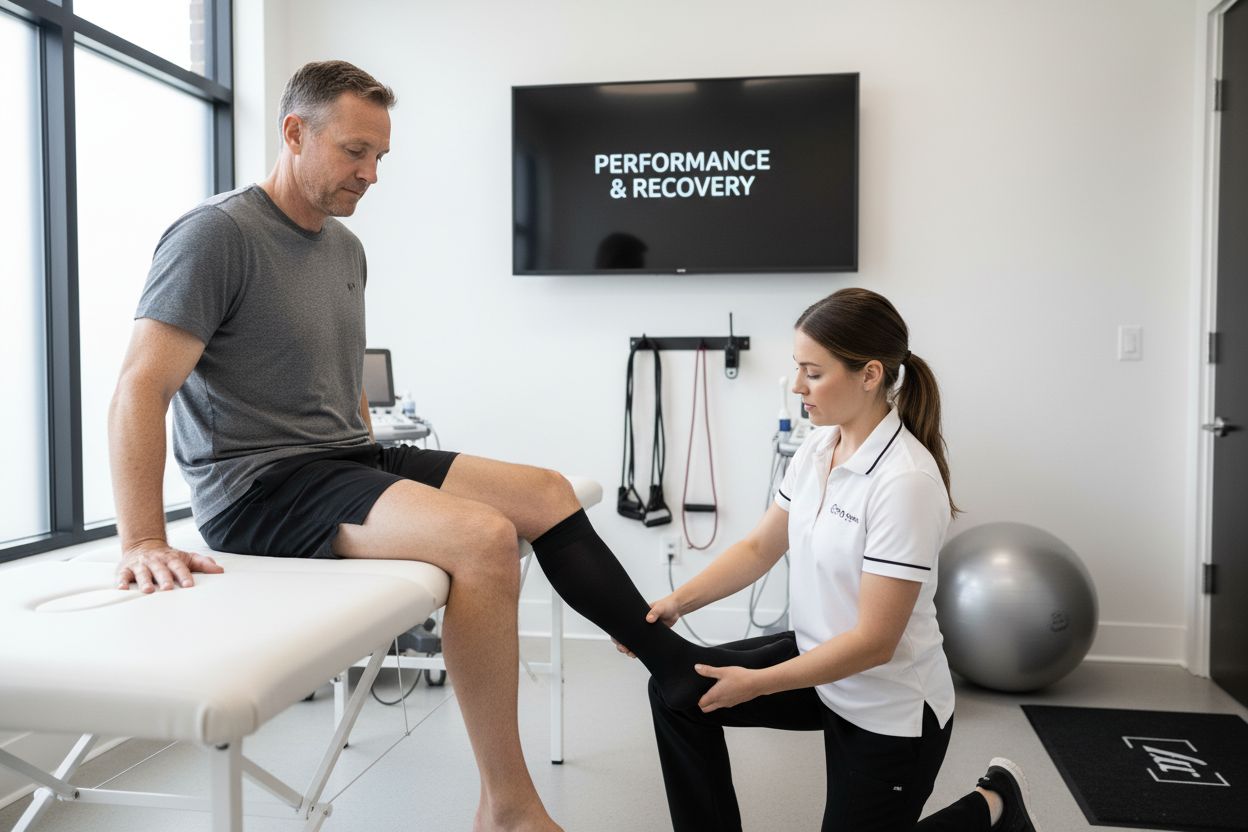
Understanding Compression Socks vs Regular Socks
Share
Compression socks look just like regular socks at first, right? People often assume they are just thicker or a little tighter, and that’s the end of the story. But the truth is, compression socks apply up to 40 mmHg of precise pressure, making a dramatic impact on blood flow and recovery. Most people have no idea that this truly separates them from what you find in an ordinary sock drawer.
Table of Contents
- Defining Compression Socks And Regular Socks
- The Importance Of Compression Therapy
- How Compression Socks Promote Circulation
- Comparing Benefits For Health And Recovery
- Real-World Uses Of Compression Socks
Quick Summary
| Takeaway | Explanation |
|---|---|
| Compression socks enhance circulation effectively | They apply graduated pressure to support blood flow from the legs to the heart, preventing circulatory issues. |
| Different pressure levels target varying needs | Compression socks come in various pressure gradients, making them suitable for different health conditions and activities. |
| Regular socks do not provide medical benefits | Unlike compression socks, regular socks simply offer comfort and warmth without aiding circulation or recovery. |
| Used across various professions | Compression socks are beneficial for nurses, pilots, and athletes, especially those experiencing prolonged sitting or standing. |
| Support for health conditions is critical | These socks help manage lymphedema, varicose veins, and promote post-surgical recovery, enhancing overall leg health. |
Defining Compression Socks and Regular Socks
Compression socks and regular socks might look similar at first glance, but they serve remarkably different purposes in supporting leg health and comfort. While regular socks primarily provide basic coverage and warmth, compression socks are specialized medical garments engineered to deliver targeted pressure and improve circulatory function.
The Anatomy of Compression Socks
Compression socks are uniquely designed therapeutic garments that apply graduated pressure along the leg. This means they exert the most pressure at the ankle and gradually decrease pressure as they move up the leg. According to medical research from the Cleveland Clinic, this strategic pressure design helps promote blood flow from the lower extremities back towards the heart.
Key characteristics of compression socks include:
- Measured in millimeters of mercury (mmHg) indicating precise pressure levels
- Available in multiple compression gradients (15-20, 20-30, 30-40 mmHg)
- Constructed from specialized elastic materials that maintain consistent pressure
Regular Socks: Comfort Without Medical Intervention
In contrast, regular socks are primarily designed for comfort, protection, and basic temperature regulation. They typically feature standard knit fabrics without the specialized elastic properties of compression socks. Unlike medical compression garments, regular socks do not provide significant circulatory benefits or therapeutic pressure.
For those interested in understanding more about different sock types, our guide on support sock variations offers additional insights into the nuanced world of specialized hosiery. Whether you need basic everyday wear or targeted medical support, understanding these differences can help you make informed choices about your leg health and comfort.
To clarify the distinct characteristics and benefits of each sock type, the following table compares key features of compression socks versus regular socks.
| Feature | Compression Socks | Regular Socks |
|---|---|---|
| Primary Purpose | Medical and therapeutic support for circulation | Comfort, warmth, and basic coverage |
| Pressure Applied | Graduated, precise pressure (measured in mmHg, up to 40 mmHg) | No significant or therapeutic pressure |
| Material | Specialized elastic fabrics for maintained compression | Standard cotton, wool, or blends |
| Key Health Benefits | Improves blood flow, manages swelling, reduces risk of clots, supports recovery | No medical or therapeutic benefits |
| Common Uses | Medical conditions, athletics, prolonged sitting/standing | Everyday wear |
| Professional Recommendation | Frequently prescribed or recommended by healthcare providers | Rarely medically recommended |
| Gradients Available | Multiple pressure gradients (15-20, 20-30, 30-40 mmHg) | Not applicable |

The Importance of Compression Therapy
Compression therapy represents a critical medical intervention designed to support circulatory health and manage various physiological conditions affecting the legs and lower extremities. By applying strategic external pressure, this therapeutic approach addresses multiple health challenges that can significantly impact an individual’s quality of life.
Addressing Circulatory Challenges
Compression therapy plays a pivotal role in managing circulatory disorders and preventing potential health complications. Research from the National Institutes of Health demonstrates that this approach helps mitigate several critical health concerns:
- Reducing swelling and edema in lower extremities
- Preventing blood pooling and potential clot formation
- Supporting venous return and improving overall circulation
- Minimizing the risk of deep vein thrombosis
The mechanism behind compression therapy involves applying graduated pressure that assists the body’s natural blood flow processes.
This pressure encourages blood to move more efficiently from the lower legs back towards the heart, counteracting gravitational challenges that can lead to circulatory stagnation.
Medical Applications and Benefits
Compression therapy extends far beyond basic circulatory support. Medical professionals frequently recommend these interventions for a wide range of conditions, including lymphedema, varicose veins, and post-surgical recovery. Athletes and individuals with sedentary lifestyles also benefit from this therapeutic approach, as it helps prevent muscle fatigue and reduces the risk of venous insufficiency.
Learn more about the comprehensive guide to compression therapy for a deeper understanding of how this treatment can transform your approach to leg health and overall well-being. Whether you are managing a specific medical condition or seeking preventative care, compression therapy offers a non-invasive solution to support your body’s natural circulatory functions.
How Compression Socks Promote Circulation
Compression socks represent an ingenious approach to supporting the body’s natural circulatory processes by strategically manipulating blood flow through external pressure. These specialized garments work on a sophisticated physiological principle that transforms how blood moves through the lower extremities.
The Biomechanics of Circulatory Support
The core mechanism of compression socks involves graduated pressure technology, which applies precise and strategic compression from the ankle upward. According to research published in the Journal of Vascular Surgery30432-2/fulltext), this graduated pressure creates a dynamic pumping effect that actively supports venous return.
Key circulatory enhancement mechanisms include:
- Compressing surface veins to increase blood flow velocity
- Reducing venous diameter to accelerate blood movement
- Mechanically assisting the muscle pump function of the lower leg
- Preventing blood pooling in the lower extremities
Physiological Benefits Beyond Blood Flow
Beyond immediate circulatory improvements, compression socks provide comprehensive physiological benefits. They help reduce muscle vibration during physical activity, which can decrease fatigue and potential microtrauma. Athletes and individuals with sedentary occupations both benefit from these advanced circulatory support garments.
Explore the top benefits of compression socks to understand how these remarkable garments can transform your approach to leg health. Whether you are managing a medical condition or seeking enhanced physical performance, compression socks offer a scientifically designed solution for optimizing circulatory function and overall well-being.
Comparing Benefits for Health and Recovery
Compression socks and regular socks represent two fundamentally different approaches to leg health, with compression socks offering substantial therapeutic advantages beyond basic comfort. Understanding these differences can help individuals make informed decisions about their personal health and recovery strategies.
Performance and Recovery Enhancement
Research from sports medicine studies demonstrates that compression socks provide remarkable benefits for athletes and active individuals. Unlike regular socks, these specialized garments actively contribute to physiological recovery and performance optimization.
Key performance and recovery benefits include:
- Reducing muscle soreness after intense physical activity
- Accelerating metabolic waste removal from muscle tissues
- Minimizing exercise-induced inflammation
- Supporting faster muscle recovery between training sessions
Health Conditions and Therapeutic Support
Compression socks transcend athletic applications, offering critical support for various health conditions. Individuals with circulatory challenges, diabetes, lymphedema, and those recovering from surgery can experience significant improvements through targeted compression technology. Regular socks simply cannot provide the same level of medical intervention and physiological support.
Learn more about compression techniques for athletic recovery and discover how these innovative garments can transform your approach to health and wellness. Whether you are an elite athlete, managing a chronic condition, or seeking preventative care, compression socks represent a scientifically backed solution for comprehensive leg health and performance optimization.

Real-World Uses of Compression Socks
Compression socks have evolved from specialized medical equipment to versatile garments addressing diverse health and lifestyle needs. Their applications extend far beyond traditional medical interventions, serving a wide range of individuals across different professions and physical conditions.
Healthcare and Medical Applications
Medical research from Johns Hopkins University reveals that compression socks play a critical role in managing numerous health conditions. Healthcare professionals frequently recommend these garments for patients experiencing circulatory challenges, chronic venous disorders, and post-surgical recovery.
Key medical uses include:
- Managing lymphedema and reducing swelling
- Preventing blood clots during extended bed rest
- Supporting patients with diabetes-related circulation issues
- Assisting in recovery from vascular surgeries
- Mitigating symptoms of varicose veins
Professional and Lifestyle Applications
Beyond medical contexts, compression socks have become essential for professionals and active individuals who spend significant time standing or sitting. Nurses, pilots, athletes, and remote workers benefit from the circulatory support these specialized socks provide. Professions involving prolonged periods of immobility or constant standing find compression socks particularly advantageous in maintaining leg health and reducing fatigue.
Here is a summary table of compression sock applications in both medical and lifestyle contexts to help you quickly identify their real-world uses.
| Application Area | Examples of Use | Population Benefiting |
|---|---|---|
| Medical/Healthcare | Managing lymphedema, reducing swelling, preventing clots, post-surgery | Patients with circulatory challenges |
| Athletic Performance | Recovery after intense activity, minimizing inflammation, muscle support | Athletes, fitness enthusiasts |
| Occupational Use | Prolonged standing or sitting (nurses, pilots, remote workers) | Professionals, frequent travelers |
| Chronic Condition Support | Diabetes-related circulation issues, varicose veins | Individuals with chronic health issues |
| Everyday Preventative Care | Reducing leg fatigue, maintaining healthy circulation | General population |
Discover compression socks designed for everyday use and explore how these innovative garments can transform your daily comfort and health management. Whether managing a specific medical condition or seeking preventative support, compression socks offer a scientifically backed solution for maintaining optimal leg wellness across various lifestyle scenarios.
Ready to Experience the Difference Compression Makes?
If you are struggling with tired legs, swelling, or discomfort from standing or sitting too long, you already know that regular socks are no match for your needs. The article explained how compression socks target true circulatory challenges by using graduated pressure to promote blood flow, reduce swelling, and help with conditions like varicose veins and lymphedema. Now, you can take control of your leg health by choosing medical-grade garments made for real relief, not just basic comfort.
Visit our Jobst Collection to discover trusted compression options in various sizes and pressure levels, including specialized solutions like 30-40 mmHg compression stockings for advanced support. Fit Stockings not only delivers top brands and expert guidance but also offers free shipping and hassle-free returns. Act now and give your legs the support they deserve by exploring Fit Stockings for your ideal compression solution.
Frequently Asked Questions
What is the main difference between compression socks and regular socks?
Compression socks are specialized medical garments that apply graduated pressure to improve blood circulation, while regular socks primarily provide comfort, warmth, and basic coverage without any therapeutic effects.
How do compression socks promote leg health?
Compression socks apply graduated pressure, which aids in venous return, reduces swelling and edema, prevents blood pooling, and helps minimize the risk of clot formation, supporting overall circulatory health.
Who can benefit from wearing compression socks?
Individuals with circulatory issues, varicose veins, lymphedema, athletes looking to enhance performance and recovery, and those on their feet for long periods can all benefit from wearing compression socks.
Can regular socks provide the same benefits as compression socks?
No, regular socks do not offer the graduated pressure necessary for promoting circulation and addressing medical concerns. They are designed mainly for comfort and do not provide the therapeutic effects of compression socks.

